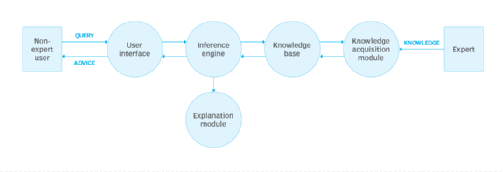Expert systems
An expert system is a computerised system that attempts to reproduce the decision-making process of an expert human beingAn expert system consists of several components. These components include:
- a user interface
- a knowledge base
- an inference engine
- an explanation system
- method of output
and using the inference engine to aid the decision-making process it is designed to simulate
Components of an expert system

User interface
The user interface is the way that a user interacts with the expert system. It will guide the user about what datathey need to input into the expert system.
Knowledge base
The knowledge base is a database of related information about a particular subject. It allows the storage and retrieval of the knowledgerequired for an expert system to operate. In developing an expert system, experts are interviewed to gather their knowledge in a
specific field. This knowledge is then used to build a database that is the knowledge base for the expert system.
The developers will want two types of knowledge from the experts, factual knowledge and heuristic knowledge.
Factual knowledge: is definitive and commonly shared among experts.
Heuristic knowledge: is derived from personal experiences and reasoning.
Knowledge base editor: a component of an expert system that is used to amend or update the knowledge base
Rules base
Rules base is part of the knowledge base. The rules base is a set of rules that will be used to produce an output or decisionby the expert system. These rules are used by the inference engine as a base for reasoning, to obtain a solution to a problem
or a decision. Each rule consists of two parts: the IF and the THEN.
Inference engine
The inference engine is the part of the expert system that makes judgements and reasoning using the knowledge baseand user responses. It is designed to produce reasoning based on the rules and the knowledge base. It will ask the user questions and,
based on their answer, it will follow a line of logic.
There are two main methods that an inference engine can use to simulate reasoning, these are backward chaining and forward chaining.
Backward chaining is based on goal driven reasoning. In backward chaining, the system tries to take a goal and
repeatedly split it into sub-goals that are simpler to achieve. The system starts with a goal or desired outcome and works backward
to find the facts that support that goal. It's like asking "Why?" to trace back the reasoning.
For ex: If the user reported flu, backward chaining would trace back to the rules and find, "IF flu THEN fever AND cough AND fatigue." Providing general symptoms of flu.
Forward chaining is based on data driven reasoning and is dependent on the data that it is provided with. The system will
take data input by the user and move forward from rule to rule to suggest a possible outcome. For ex if the user reports symptoms
like fever, cough, and fatigue, the app might use forward chaining to conclude,
"IF fever AND cough AND fatigue THEN it could be flu."

Explanation system
The explanation system is the part of an expert system that provides an explanation of how an outcome was achievedAdvantages of expert system
| Expert system | |
| Advantages | Disadvantages |
| can provide answers to questions that are outside the knowledge that you currently have |
do not have the intuition that humans have. Their response can only be a logical one and may not be useful. |
| Aids professionals by prompting them and guiding them to look at areas of knowledge they may not have considered or remembered |
are only as good as the rules and data they are provided with. |
| consistent responses produced as they are arrived at in a logical way |
are expensive to create |
| can be used at any time | cannot adapt a great deal to their environment and may require the knowledge base to be edited |
| can arrive at a solution to a problem quicker than a human would | |
Applications of expert systems
- Medical symptoms
- Car engine fault diagonistics
- Financial planning
- Insurance planning
- Plant identification